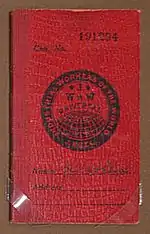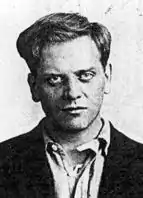Ralph Chaplin
Ralph Hosea Chaplin (1887–1961) was an American writer, artist and labor activist. At the age of seven, he saw a worker shot dead during the Pullman Strike in Chicago, Illinois. He had moved with his family from Ames, Kansas to Chicago in 1893. During a time in Mexico he was influenced by hearing of the execution squads established by Porfirio Díaz, and became a supporter of Emiliano Zapata. On his return, he began work in various union positions, most of which were poorly paid. Some of Chaplin's early artwork was done for the International Socialist Review and other Charles H. Kerr publications.

Ralph Hosea Chaplin | |
|---|---|
 | |
| Born | 1887 |
| Died | 1961 |
| Occupation | Labor activist, songwriter, illustrator |
For two years Chaplin worked in the strike committee with Mother Jones for the bloody Kanawha County, West Virginia strike of coal miners in 1912–13. These influences led him to write a number of labor oriented poems, one of which became the words for the oft-sung union anthem, "Solidarity Forever".
Chaplin then became active in the Industrial Workers of the World (the IWW, or "Wobblies") and became editor of its eastern U.S. publication Solidarity. In 1917 Chaplin and some 100 other Wobblies were rounded up, convicted, and jailed under the Espionage Act of 1917 for conspiring to hinder the draft and encourage desertion. He wrote Bars And Shadows: The Prison Poems while serving four years of a 20-year sentence.

Although he continued to work for labor rights after his release from prison, Chaplin was very disillusioned by the aftermath of the Russian Revolution and the evolution of the Soviet state and international communism, particularly its involvement in American politics and unions in 1920–1948, as he details in his autobiography, Wobbly.
However, he was also not pleased by the course of New Deal liberalism. Chaplin maintained his involvement with the IWW, serving in Chicago as editor of its newspaper, the Industrial Worker, from 1932 to 1936. He became active in the cause of preventing Communist infiltration in American unions.
Eventually Chaplin settled in Tacoma, Washington, where he edited the local labor publication. From 1949 until his death he was curator of manuscripts for the Washington State Historical Society.
He is credited with designing the now widely used anarcho-syndicalist image, the black cat. As its stance indicates, the cat is meant to suggest wildcat strikes and radical unionism.

See also
References
- Ralph Chaplin, Wobbly: The Rough-and-Tumble Story of an American Radical (The University of Chicago Press, 1948).
- Ralph Chaplin, "Confessions of a Radical," two-part article in Empire Magazine of the Denver Post, Feb. 17, 1957, pp. 12–13, and Feb. 24, 1957, pp. 10–11.
- Ralph Chaplin, "Why I Wrote Solidarity Forever," American West, vol. 5, no. 1 (January 1968), 18–27, 73.
External links
 Media related to Ralph Chaplin at Wikimedia Commons
Media related to Ralph Chaplin at Wikimedia Commons Quotations related to Ralph Chaplin at Wikiquote
Quotations related to Ralph Chaplin at Wikiquote Works written by or about Ralph Chaplin at Wikisource
Works written by or about Ralph Chaplin at Wikisource- Works by Ralph Chaplin at Project Gutenberg
- Works by or about Ralph Chaplin at Internet Archive
- Works by Ralph Chaplin at LibriVox (public domain audiobooks)

- CHAPLIN, Ralph Hosea (1887-1961), papers, 6 l.f. Special Collections, Washington State Historical Society
- Grave of Ralph Chaplin Calvary Cemetery, Tacoma, Washington
